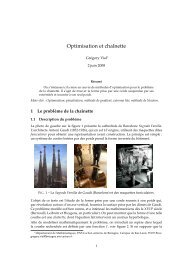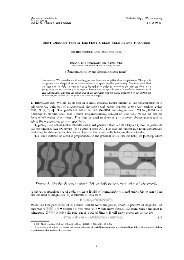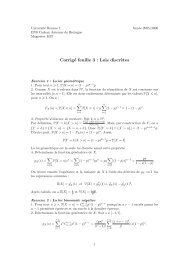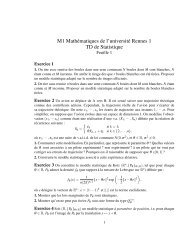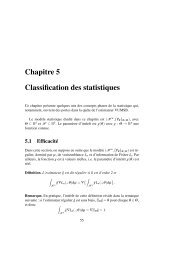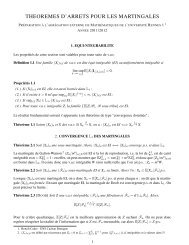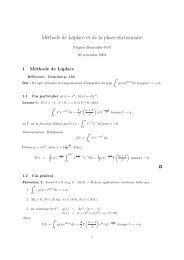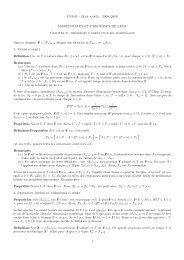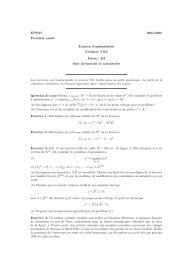Bath Institute For Complex Systems - ENS de Cachan - Antenne de ...
Bath Institute For Complex Systems - ENS de Cachan - Antenne de ...
Bath Institute For Complex Systems - ENS de Cachan - Antenne de ...
You also want an ePaper? Increase the reach of your titles
YUMPU automatically turns print PDFs into web optimized ePapers that Google loves.
2 Preliminaries2.1 NotationGiven a probability space (Ω, A, P) and a boun<strong>de</strong>d Lipschitz domain D ⊂ R d , we introduce thefollowing notation. <strong>For</strong> any k ∈ N, we <strong>de</strong>fine on the Sobolev space H k (D) the following semi-normand norm:( ∫∑1/2 ( ∫∑1/2|v| H k (D) = |D α v| dx) 2 and ‖v‖ H k (D) = |D α v| dx) 2 .D|α|=kD|α|≤kWe recall that, since D is boun<strong>de</strong>d, the semi-norm | · | H k (D) <strong>de</strong>fines a norm equivalent to the norm‖ · ‖ H k (D) on the subspace H0 k(D) of Hk (D). <strong>For</strong> any real r ≥ 0, with r /∈ N, set r = k + s withk ∈ N and 0 < s < 1, and <strong>de</strong>note by | · | H r (D) and ‖ · ‖ H r (D) the Sobolev–Slobo<strong>de</strong>tskii semi-normand norm, respectively, <strong>de</strong>fined for v ∈ H k (D) by( ∫∫|v| H r (D) =D×D∑|α|=k[D α v(x) − D α v(y)] 2|x − y| d+2s dx dy) 1/2 (1/2and ‖v‖ H r (D) = ‖v‖ 2 H k (D) +|v|2 H (D)) r .The Sobolev space H r (D) is then <strong>de</strong>fined as the space of functions v in H k (D) such that theintegral |v| 2 H r (D) is finite. <strong>For</strong> 0 < s ≤ 1, the space H−s (D) <strong>de</strong>notes the dual space to H0 s (D) withthe dual norm.In addition to the above Sobolev spaces, we also make use of the Höl<strong>de</strong>r spaces C t (D), with0 < t < 1, on which we <strong>de</strong>fine the following semi-norm and norm|v| C t (D) = sup |v(x) − v(y)|x,y∈D: x≠y|x − y| t and ‖v‖ C t (D) = sup |v(x)| + |v| C t (D) .x∈DThe spaces C 0 (D) and C 1 (D) are as usual the spaces of continuous and continuously differentiablefunctions with the standard norms.Finally, we will also require spaces of Bochner integrable functions. To this end, let B be aBanach space with norm ‖ · ‖ B , and v : Ω → B be strongly measurable. With the norm ‖ · ‖ L p (Ω,B)<strong>de</strong>fined by{(∫‖v‖ L p (Ω,B) =Ω ‖v‖p B dP) 1/p , for p < ∞,esssup ω∈Ω ‖v‖ B , for p = ∞,the space L p (Ω, B) is <strong>de</strong>fined as the space of all strongly measurable functions on which this normis finite. In particular, we <strong>de</strong>note by L p (Ω, H k 0 (D)) the Bochner space where the norm on Hk 0 (D)is chosen to be the seminorm | · | H k (D). <strong>For</strong> simplicity we write L p (Ω) for L p (Ω, R).The key task in this paper is keeping track of how the constants in the bounds and estimates<strong>de</strong>pend on the coefficient a(ω, x) and on the mesh size h. Hence, we will almost always bestating constants explicitly. To simplify this task we shall <strong>de</strong>note constants appearing in Theorem/Proposition/Corollaryx.x by C x.x . Constants that do not <strong>de</strong>pend on a(ω, x) or h will not beexplicitly stated. Instead, we will write b c for two positive quantities b and c, if b/c is uniformlyboun<strong>de</strong>d by a constant in<strong>de</strong>pen<strong>de</strong>nt of a(ω, x) and of h.2.2 Problem SettingWe consi<strong>de</strong>r the following linear elliptic partial differential equation (PDE) with random coefficients:−∇ · (a(ω, x)∇u(ω, x)) = f(ω, x), in D, (2.1)u(ω, x) = 0, on ∂D,3




